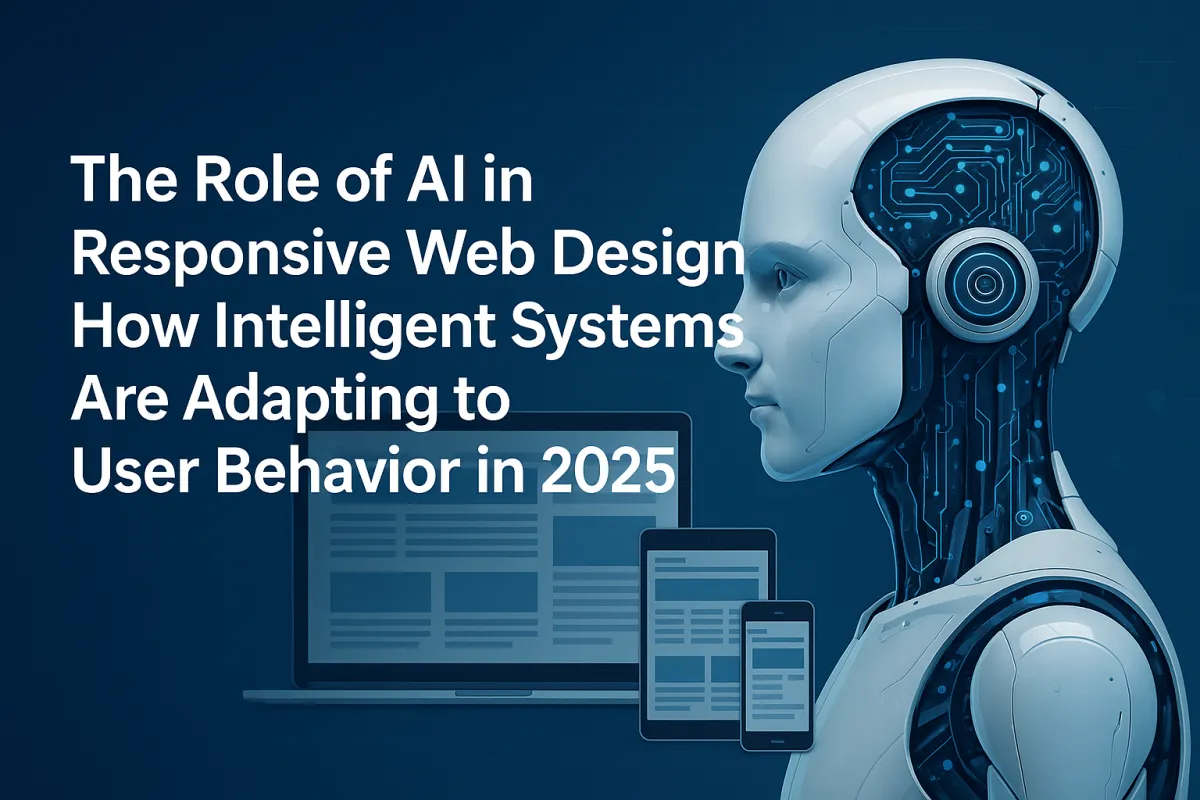
The Role of AI in Responsive Web Design: How Intelligent Systems Are Adapting to User Behavior in 2025
As we step deeper into the digital future, artificial intelligence (AI) has moved beyond being a tech buzzword to becoming a transformative force in web development. In 2025, AI’s impact on responsive web design is more profound than ever. Gone are the days when responsiveness simply meant adjusting layouts to screen sizes. Today, intelligent systems are analyzing user behavior in real time and reshaping the way websites respond, engage, and perform.
What Is Responsive Web Design in 2025?
Responsive web design (RWD) traditionally refers to a website's ability to adapt its layout to different screen sizes and devices — from desktops to smartphones. In 2025, this concept has evolved dramatically.
Modern RWD is now context-aware and behavior-driven, thanks to AI. Websites not only adjust to screen size but also:
Adapt layout based on user interaction patterns,
Personalize content dynamically,
Optimize navigation paths in real time,
Predict and pre-load relevant resources based on usage behavior.
This AI-enhanced responsiveness ensures a seamless and tailored user experience like never before.
The Role of AI in Analyzing User Behavior
At the core of this transformation is AI’s ability to gather and interpret vast amounts of user data. Through machine learning algorithms, AI systems can analyze:
Scroll depth,
Click patterns,
Time spent on pages,
Mouse movement or touch gestures,
Device types and browsing history.
By identifying user intent and interaction trends, AI can make real-time design adjustments that improve usability and engagement.
For example, if a user repeatedly ignores a call-to-action (CTA) button on mobile, the system may shift its position, change its color, or even reword it — all automatically.
Adaptive Layouts: Beyond Static Breakpoints
In traditional responsive design, layouts change at predefined breakpoints (e.g., 768px for tablets). AI replaces this rigid system with fluid, adaptive layouts that respond to actual user needs rather than device specs alone.
Key AI-driven layout adaptations include:
Dynamic component resizing based on user attention areas.
Content reordering for better readability based on user demographics or interaction history.
Smart grids that rearrange in real time depending on screen orientation and engagement metrics.
This intelligent responsiveness ensures each user sees the most relevant and accessible version of a page.
Personalized User Experiences
AI takes personalization far beyond “Welcome back, John!” In 2025, intelligent systems personalize design elements such as:
Color schemes (based on time of day or user mood),
Font sizes (depending on user’s past preferences or accessibility settings),
Navigation paths (based on user goals and past actions).
These micro-adjustments create a highly personalized user journey that feels intuitive and frictionless.
AI Tools Powering Responsive Design
Several cutting-edge tools are driving this AI revolution in responsive design:
1. Adobe Sensei
Adobe's AI platform uses behavioral insights to automate layout adjustments, suggest design improvements, and enhance accessibility.
2. Figma AI Plugins
With intelligent suggestions and layout optimization, designers can create responsive prototypes that evolve with user testing.
3. ChatGPT + Webflow Integrations
These tools combine conversational AI with responsive design tools to dynamically adjust content and layout based on input and context.
4. Framer AI
Allows developers to build fully responsive pages by describing behavior in plain language, which AI turns into functioning, adaptive layouts.
Benefits of AI-Driven Responsive Design
The integration of AI into responsive web design delivers several benefits:
Improved UX: Real-time layout and content adjustments reduce friction and increase user satisfaction.
Faster Load Times: AI can pre-load only the most relevant assets based on predicted user behavior.
Higher Conversions: Personalized layouts and CTAs are more likely to engage and convert users.
Accessibility Compliance: AI can identify accessibility issues and auto-correct elements for better inclusivity.
Challenges and Ethical Considerations
Despite its potential, AI-powered responsive design isn’t without challenges:
Privacy Concerns: Behavioral tracking can raise concerns about data usage and user consent.
Over-Personalization: Excessive automation may feel intrusive or confusing to users.
Design Control: Designers may struggle with balancing automation with creative direction.
Web creators must ensure ethical use of AI, with transparent data policies and manual overrides when necessary.
Looking Ahead: What’s Next?
As AI continues to mature, we can expect:
Deeper integration with voice and gesture-based navigation.
Emotion detection influencing layout and content.
Augmented reality (AR)-responsive elements adjusting based on environmental input.
The future of responsive design lies not just in fitting devices, but in understanding humans — their needs, emotions, and behaviors — and using intelligent systems to meet them in real time.
Final Thoughts
AI is not just changing how websites look — it's transforming how they think. In 2025, responsive web design is no longer a static technical approach, but a dynamic, intelligent process powered by data, behavior analysis, and creativity.
For businesses and designers alike, embracing AI means delivering richer, more meaningful, and highly personalized user experiences. The era of intelligent responsiveness is here — and it's just getting started.